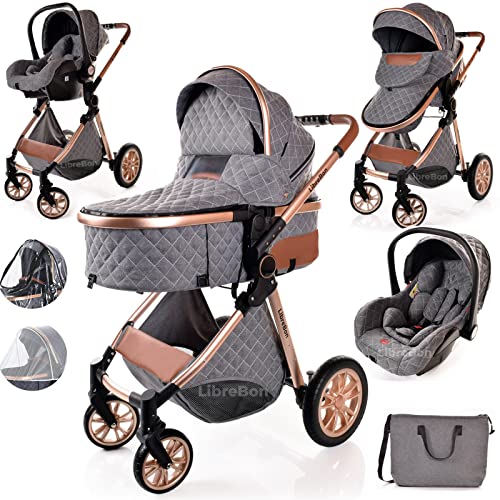10 Startups That'll Change The Prams Industry For The Better

Prams and Pushchairs: A Comprehensive Guide for New Parents
Browsing the world of baby transport can be overwhelming for new parents, especially when it comes to picking between prams and pushchairs. Each alternative offers distinct benefits and constraints, indicating that making a notified choice is essential. This short article aims to supply a thorough understanding of prams and pushchairs, their differences, functions to consider, and pointers for picking the ideal one.
Understanding the Basics: Prams vs. Pushchairs
Prams and pushchairs are terms often utilized interchangeably, but they describe various kinds of baby transport systems.
Definitions:
- Prams: Traditionally created for newborns and babies, prams have a large, completely flat bassinet that permits for ideal convenience and safety during early phases of a kid's life.
- Pushchairs: Designed for older babies and toddlers, pushchairs generally have an upright seat that is ideal for children who can support their head and neck. They often come with adjustable recline alternatives.
Secret Differences
| Function | Pram | Pushchair |
|---|---|---|
| Design | Flat bassinet | Upright seat |
| Age Suitability | Newborn to around 6 months | 6 months to 4 years |
| Portability | Generally much heavier, less foldable | Frequently light-weight and foldable |
| Convenience | Relaxing for newborns, snug fit | Adjustable, can be reclined |
| Use | Perfect for strolls and leisure | Versatile for daily activities and travel |
Functions to Consider When Choosing Prams and Pushchairs
Security Features
- Harness systems (5-point vs. 3-point)
- Braking systems (foot-operated vs. hand-operated)
- Stability and durability of the frame
Weight and Portability
- Think about the weight of the pram or pushchair
- Search for a design that folds easily for transportation
Size and Storage
- Check dimensions for fitting through entrances and in vehicle trunks
- Try to find additional storage options like baskets or pockets
Comfort
- Padded seats and adjustable recline positions
- Suspension systems for smoother rides on rough surfaces
Weather condition Protection
- UV defense in sunshades
- Options for rain covers and windshields
Wheels and Maneuverability
- Wheel size and type (repaired vs. swivel)
- Suspension systems that help handling and comfort
Durability
- Designs that convert from pram to pushchair
- Stronger frames that can accommodate growing kids
Popular Types of Prams and Pushchairs
When considering prams and pushchairs, parents often discover various designs accommodating specific needs. Here are some widely known types:
1. Standard Prams/Pushchairs
These are great all-rounders, developed for daily usage with a durable frame and adequate storage area. They are frequently adjustable and can manage numerous surfaces.
2. Travel Systems
These consist of a vehicle seat and a stroller that can be used together, making it simple to transfer the baby from the cars and truck to the pram without waking them up.
3. Umbrella Strollers
These are light-weight and foldable, ideal for quick getaways and travel. While hassle-free, they typically lack some of the security and comfort features found in heavier designs.
4. All-Terrain Strollers
Created for off-road adventures, these strollers have larger wheels and a more rugged frame, making them ideal for active households.
Selecting the Right Pram or Pushchair
When choosing the best pram or pushchair, moms and dads need to take the following steps:
- Assess Lifestyle Needs: Consider how you will utilize the pram or pushchair (everyday strolls, travel, unequal surface) and choose accordingly.
- Test Drive: It's beneficial to physically evaluate the designs at the shop, looking for managing, comfort, and weight.
- Research study Brands: Look at evaluations and recommendations from other parents about specific brand names or models.
- Consider Future Needs: Think ahead to make sure the choice will work as the child grows. Convertible designs offer flexibility.
- Budget: Set a spending plan but also aspect in quality and longevity. Sometimes investing more at first can save costs in the long run.
Frequently Asked Questions
What is the best age to start utilizing a pushchair?
The majority of pushchairs can be used for babies from about 6 months old when they can properly support their heads and necks. Make certain to check the producer's specifications.
Are prams suitable for newborns?
Yes, prams are preferably matched for newborns due to their flat bassinet design, providing a comfy and safe environment.
How do I clean a pram or pushchair?
Constantly describe the producer's standards, but most covers are removable and can be washed. Wipe down the frame with a wet fabric and avoid using harsh chemicals.
Can I use a pram or pushchair on public transportation?
Various designs differ in size; light-weight and foldable alternatives are generally better for buses or trains. Nevertheless, constantly examine for transportation guidelines in your location.
How long can I use a pram or pushchair?
It typically depends on the weight limitation defined by the producer, typically in between 15-50 pounds, or until your child no longer desires to be pushed.
Picking in between a pram and a pushchair is a considerable choice that deals with the way of life and requirements of both the moms and dad and the child. By understanding view in between the two, evaluating crucial features, and choosing the right design, parents can guarantee they have a safe, comfy, and practical transport solution for their little ones.
Arming oneself with knowledge offers moms and dads not only comfort however also the self-confidence to make the very best choice for their child's early experience into the world. Different lifestyles demand various services, so putting in the time to research and test what fits can alleviate a few of the tensions that come with brand-new being a parent. Pleased strolling!

